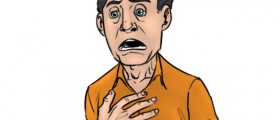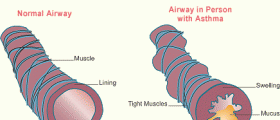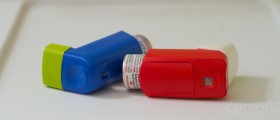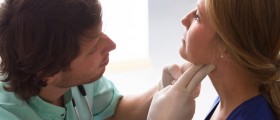
The trachea is a cartilage tube and represents the initial part of the lower respiratory tract. It connects the pharynx and larynx to the lungs and allows normal passage of the air to and from the lungs. This tube is approximately 3.9 to 6.3 inches long and its inner diameter is around 0.83 to 1.1 inches. The trachea begins at the larynx (at the level of the fifth cervical vertebra) and ends at the level of the fourth or fifth thoracic vertebra. At the distal end the trachea bifurcates into the primary bronchi.
The trachea consists of fifteen to twenty incomplete C-shaped cartilaginous rings. These rings reinforce the anterior and lateral walls of the trachea and prevent collapse of this organ. The ends of the rings are connected by the trachealis muscle. This muscle contracts during coughing and this reduces the lumen of the trachea. The rings are not complete and this is what allows the food to pass normally through the esophagus which is placed next to the posterior wall of the trachea. Food and fluids cannot normally enter the trachea due to the epiglottis which closes the opening of the larynx during the act of swallowing.
The Function of Trachea
The inner layer of the trachea consists of goblet cells and ciliated epithelial cells. Ciliated epithelial cells are in charge of mucus production. The mucus is necessary since it moistens the air during its passage to the lungs. Another function of the mucus is to trap inhaled particles such as dust or bacteria and prevent their entrance into the lower part of respiratory tract. The particles which are trapped by the mucus are transported via the larynx and the pharynx, swallowed and eliminated into the stomach.
The primary function of the trachea is letting of the air flow into the lungs i.e. proper exchange of the air rich in oxygen and the air rich in carbon dioxide. Any damage to the trachea which causes its collapse or blockage interferes in normal exchange of the previously mentioned air and if not treated urgently leads to death.
If some foreign object accidentally enters the trachea ciliary cells are irritated and they induce the act of coughing. This way trachea tries to expel the foreign object and allow the air to reach the lungs. Irritation of the ciliary cells also occurs in infections where the presence of infective agents and excess of mucus leads to cough. The irritation of the ciliary cells therefore leads to a specific lifesaving reflex - cough.
In acute blockage of the trachea, patients require urgent intubation, and if this is not possible one undergoes urgent tracheotomy. In intubation a tube is placed through the nose or mouth down to the trachea. In tracheotomy a well experienced doctor performs a surgical incision in the throat and the tube is inserted directly into the trachea which allows normal breathing.
- medlineplus.gov/ency/article/001084.htm
- medlineplus.gov/trachealdisorders.html
- Photo courtesy of Tom Ventura by Flickr: www.flickr.com/photos/tgv/30730566














-And-Breathing-Problems_f_280x120.jpg)


Your thoughts on this
Loading...